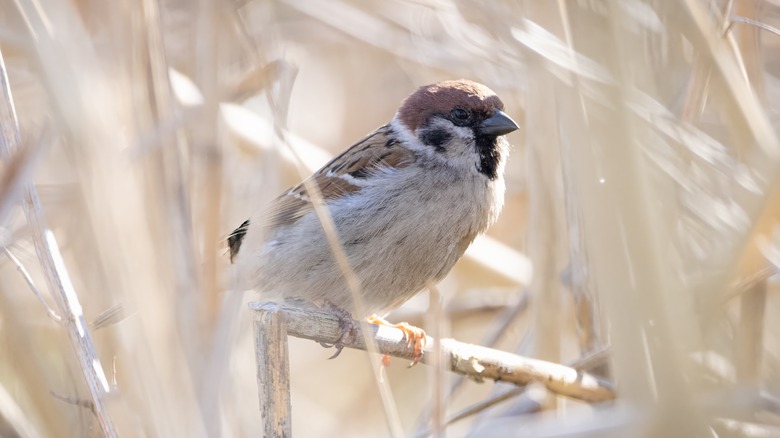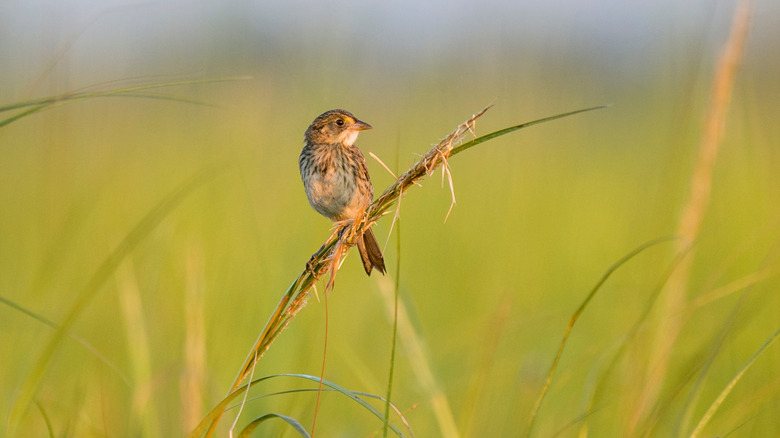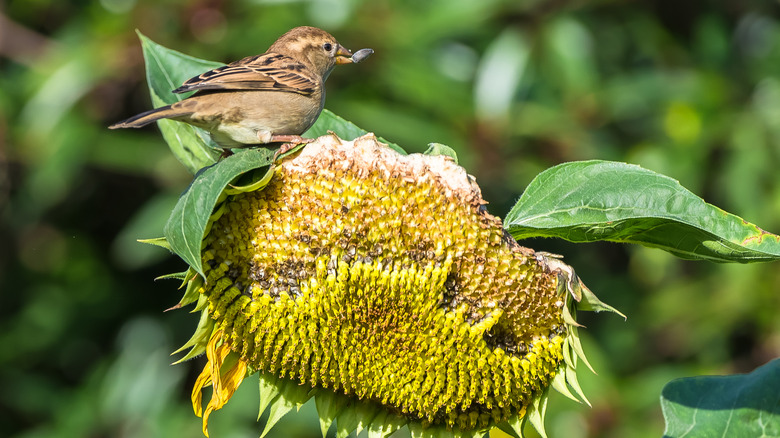Sparrows Will Flock To Your Yard If You Plant These Items
For as small and unassuming as it looks on the outside, a sparrow's big, bold personality is quite divisive among gardeners. In one camp, it's frequently categorized as a bird you don't want in your yard due to its aggressive nature and shrill call. Conversely, some homeowners consider these birds to be beneficial to the ecosystem — and more specifically, their gardens, given the avian's appetite for small insects and worms. However, bugs aren't a sparrow's primary food source, they prefer seeds and grains. Still, whether you love them or loathe them — sparrows will flock to your yard if you plant ornamental grasses and sunflowers.
Ornamental grasses, such as native prairie grasses, are hardy self-seeders that spill their bounty on the ground below creating a virtual smorgasbord for hungry sparrows. Drooping sunflowers likewise add to the bird buffet. Consequently, gardens that feature these plantings will likely attract scads of sparrows, since they like to use bulky clumps of native grasses as material for their nests. For house sparrows, this could mean nesting in dryer vents, soffits, and other sheltered crevices. In addition, house sparrows are naturally gregarious and tend to feed in flocks. As such, there is the potential of hosting a significant number of these social birds depending on the vigor of your vegetation.
How to attract sparrows with ornamental grasses
The sights and sounds of ornamental grasses swaying in the wind make them an ideal choice for any yard, but especially one you're designing to entice sparrows. Native grasses are bursting with life thanks to their seed-filled plumes, spikes, or sprays. Those seeds provide valuable nutrition to sparrows while the grasses themselves serve as a shelter from the elements and protection from predators.
If you are selecting ornamental grasses primarily to lure sparrows to your garden, consider adding Blue Fescue, Little Bluestem, Canada Wild Rye, Indian Grass, or Tufted Hairgrass. Not only do the native grasses thrive with minimal maintenance, but they feature color and texture that work well as an accent to flower beds and borders while beautifully mixing with perennials and wildflowers. Moreover, they provide consistency and longevity as they can be left alone to stand with their seed heads throughout the winter months. In the spring all that's needed is a quick trim that places them a few inches above the soil.
Generally, most native grasses bloom best in full sun and prefer well-draining soil. As for spacing, pay special attention to the distance between the greenery, as it makes a difference when accommodating sparrows. Since the birds scratch for fallen seeds, you want to leave roughly 1 to 3 feet of open area between each grass depending on the species. Doing so will allow adequate clearance for flocking sparrows to dine on dispersed seeds without jostling for legroom.
How to attract sparrows with sunflowers
If you're a gardener with an established tube bird feeder, you may be wondering why sparrows aren't flocking to your yard even when you diligently fill the device with sunflower seeds. While the mischievous birds are game for frequenting a seed-filled diner, they prefer one located on the ground level, not an elevated version with a view.
Cultivating your own sunflowers, which naturally disperse seeds on the ground with help from people, animals, and the wind, caters to sparrows' customary feeding habits. The diminutive birds instinctively scavenge for food by hopping on both feet. Consequently, feeders that require sparrows to cling to narrow perches are turn-offs that the birds tend to avoid. You're better off developing a robust ground-feeding area in your yard. Doing so can typically double the number of sparrows that visit as opposed to relying exclusively on a hanging bird feeder.
Fortunately, planting sunflower seeds isn't a laborious task. Their success in your yard simply requires fertile soil and full sunlight. Spacing is also a factor, which is why it's important to decide between regular or jumbo-sized sunflowers prior to selecting the ideal spot in your garden to plant. The former needs to be placed anywhere from 8 to 12 inches apart while the latter demands between 16 and 20 inches to prosper. While sunflowers are considered drought-resistant, they will generate a more prolific seed harvest when given a few inches of water per week.


